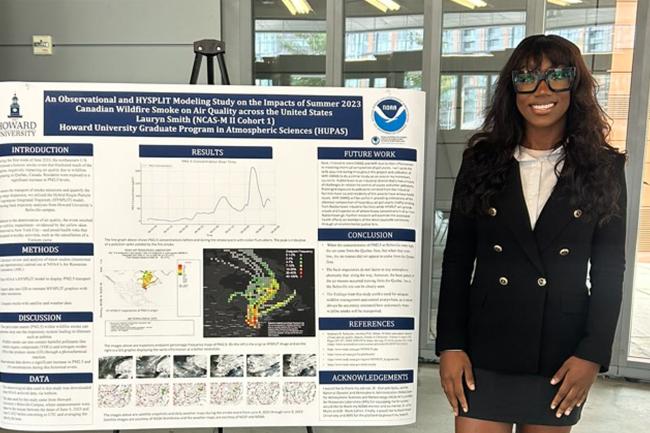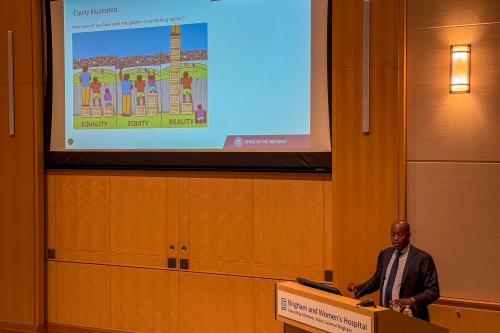One week out from her thesis defense, Lauryn Smith is in Howard’s Louis Stokes Health Library, running through her talk with her colleagues, projecting slides on the wall in the Atmospheric Science office. The beautiful spring day outside contrasts sharply with her topic: the 2023 Canadian wildfires, which blanketed D.C. in a thick cloud of orange smoke.
A Master of Science in Atmospheric Science candidate in Howard’s Graduate School, Smith’s research focuses on how atmospheric conditions combined to form a sort of highway for smoke to travel from Quebec before slowing down in the Northeast U.S. She used HYSPLIT, an atmospheric modeling system developed by the National Oceanic and Atmospheric Administration (NOAA) to simulate the conditions in the Northeast during the wildfires. Her model showed that factors including a low-pressure “trough” in the upper atmosphere created ideal conditions for smoke to travel quickly south. In D.C., more stable atmospheric conditions trapped the smoke closer to the ground, leading to higher pollutant levels across several days.
Her HYSPLIT findings closely correlated with measurements she acquired from sensors at the HU Beltsville Campus, which showed spikes of pollutants including black carbon, sulfur dioxide, and carbon monoxide, peaking on June 7, 2023 — one of the worst air quality days recorded in recent history for the Northeast United States.
Describing herself as having “always been a STEM science nerd,” Smith was motivated to study atmospheric science by her time growing up in Rubbertown, an industrial district in Louisville, Kentucky known for its high rates of pollution from factories.
“So back home I remember a different smell would fill the air,” she said. “I remember alarms going off from some of these manufacturing facilities that you can hear and you’d go ‘what the heck does that mean? Do we need to go somewhere indoors?’ “And once I got older, I realized it’s because of this industrial facility and started reading up on it more.”
After learning more about the science of these emissions and the social structures that led to them, Smith, then studying geography at the University of Kentucky, switched her major to atmospheric chemistry.
Swept in a Community of Researchers
While still an undergrad, Smith was initially drawn to Howard’s Graduate School by a webinar on its Atmospheric Sciences program and its rolling admissions. Once she was admitted, she wasted no time in getting right to work.
“They told me they would cover my application fee since I joined the meeting,” she said.” So I applied that day, and literally the next month, I found out I got admitted to Howard. Then I graduate, and the month after that I’m in D.C. So it all happened very, very quickly.”
Since attending Howard my connections have expanded so quickly and so vastly,”
Smith took these rapid changes in stride. Although her research load doesn’t allow for a lot of free time — especially as she prepares for her thesis defense — she goes to the gym to destress and “get away from all the things associated with crazy research.” She’s also relied on one of Howard’s greatest strengths: it’s far-reaching research community. She quickly grew close with her classmates and found a support network of mentors that opened new doors for her research journey.
“Since attending Howard my connections have expanded so quickly and so vastly,” Smith explained. “I’ve met so many more people within my two and a half, three years at Howard then I did in Kentucky."
Dr. LaToya Myles and Dr. Mark Cohen mentored Smith during a National Center for Atmospheric Science and Meteorology fellowship and were pivotal to her choosing a thesis topic. They also introduced her to the HYSPLIT system that was critical to her research.
Another important connection she made was with Yaítza Luna-Cruz, Ph.D. An atmospheric researcher and Howard alumna, Luna-Cruz mentored Smith during an internship at NASA headquarters, where she focused on another passion: environmental justice.

“There’s a huge intersection,” Smith said when asked how the internship related to her current atmospheric research. “My technical title was environmental justice subject matter expert. I informed the science mission directorate on issues that were currently happening and the historic environmental justice issues that are a recurring phenomenon in communities globally.”
Lack of education on hazards like unclean drinking water or unsafe air was another important issue to her, one which she also highlighted in a presentation during Howard’s Extreme Weather Symposium.
A life dedicated to research
As she leaves Howard, Smith is set on continuing to pursue her research, which she hopes will lead to more accurate atmospheric models that in turn lead to faster, more accurate forecasts of hazardous conditions that often affect the most vulnerable communities.
“I definitely plan on pursuing my Ph.D. and spending the rest of my life advocating for people who don’t know how they are affected by what happens, by the policies made by politicians and the things that are allowed, because it’s really tearing down our environment, degrading the resources we have here, which in turn affects our quality of life,” Smith said. “That’s my passion, and what I want to devote my work to for the rest of my life.”





